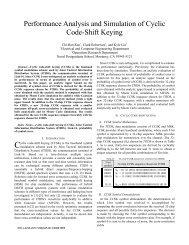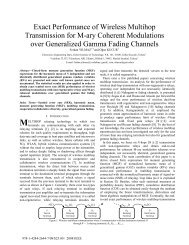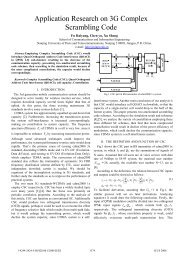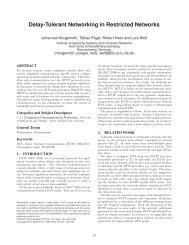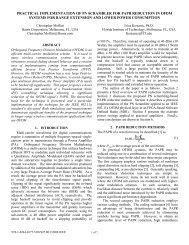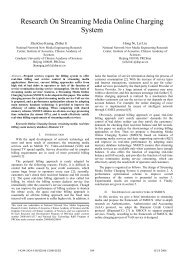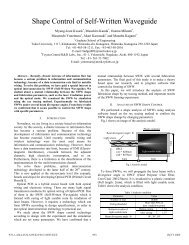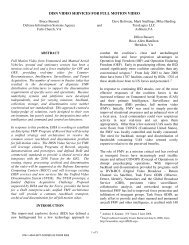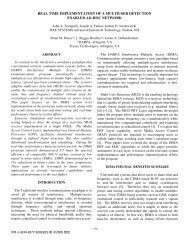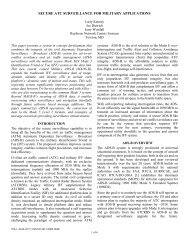Preparation of Papers in Two-Column Format for the Proceedings of ...
Preparation of Papers in Two-Column Format for the Proceedings of ...
Preparation of Papers in Two-Column Format for the Proceedings of ...
Create successful ePaper yourself
Turn your PDF publications into a flip-book with our unique Google optimized e-Paper software.
An Improved TFMCC Protocol Based on End-to-End<br />
Unidirectional Delay Jitter<br />
Shum<strong>in</strong> Yue Yewen Cao<br />
School <strong>of</strong> In<strong>for</strong>mation Science and Eng<strong>in</strong>eer<strong>in</strong>g School <strong>of</strong> In<strong>for</strong>mation Science and Eng<strong>in</strong>eer<strong>in</strong>g<br />
Shandong University Shandong University<br />
J<strong>in</strong>an, P.R. Ch<strong>in</strong>a J<strong>in</strong>an, P.R. Ch<strong>in</strong>a<br />
yueshum<strong>in</strong>2008@163.com ycao@sdu.edu.cn<br />
Abstract-TFMCC is a representative s<strong>in</strong>gle rate multicast<br />
congestion control protocol. It uses packet loss ratio as <strong>the</strong> only<br />
congestion signal and lacks efficient control mechanism <strong>for</strong> endto-end<br />
unidirectional delay jitter. Multimedia applications have a<br />
high requirement <strong>of</strong> real-time and stability. It is significant <strong>for</strong><br />
multimedia applications to detect congestion <strong>in</strong> time be<strong>for</strong>e <strong>the</strong><br />
packet loss occurs <strong>in</strong> order to reduce delay and delay jitter.<br />
TFMCC is not efficiently suited <strong>for</strong> <strong>the</strong> multimedia applications.<br />
In this paper, end-to-end unidirectional delay jitter between <strong>the</strong><br />
source and <strong>the</strong> CLR is used as a <strong>for</strong>ecast congestion signal to<br />
adjust <strong>the</strong> source send<strong>in</strong>g rate be<strong>for</strong>e <strong>the</strong> packet loss occurs.<br />
Delay, delay jitter and packet loss ratio can be efficiently reduced<br />
by our new algorithm. Our new algorithm improves <strong>the</strong> stability<br />
<strong>of</strong> TFMCC protocol and adapts to <strong>the</strong> real-time multimedia<br />
applications better. Through NS2 Simulation, <strong>the</strong> results show<br />
that our algorithm br<strong>in</strong>gs remarkable per<strong>for</strong>mance ameliorate to<br />
average end-to-end delay, average delay jitter and packet loss<br />
ratio on <strong>the</strong> premise <strong>of</strong> preserv<strong>in</strong>g TCP-Friendl<strong>in</strong>ess with TCP<br />
flows.<br />
Keywords-TFMCC protocol, congestion signal, end-to-end<br />
unidirectional delay jitter, stability, real-time, NS2 Simulation<br />
I. INTRODUCTION<br />
Recently, multimedia applications such as audio<br />
conferences and <strong>in</strong>teractive games are becom<strong>in</strong>g <strong>in</strong>creas<strong>in</strong>gly<br />
universal as new Internet services. These applications have<br />
two dist<strong>in</strong>ct characteristics: po<strong>in</strong>t-to-multipo<strong>in</strong>t and <strong>the</strong><br />
requirement <strong>of</strong> huge bandwidth. Multicast protocol is an<br />
efficient solution <strong>for</strong> multicast applications <strong>for</strong> <strong>the</strong> sake <strong>of</strong><br />
sav<strong>in</strong>g bandwidth <strong>of</strong> <strong>the</strong> bottleneck l<strong>in</strong>k. Mostly, multimedia<br />
applications are established on UDP which is a “best-ef<strong>for</strong>t<br />
delivery” protocol and has no network congestion control. IP<br />
Multicast [1] applications provide no guarantee <strong>for</strong> reliable<br />
data delivery, which results <strong>in</strong> <strong>in</strong>determ<strong>in</strong>ate network<br />
transmission and unfair competition with TCP flows.<br />
Transmission Control Protocol (TCP) [2] is an end-to-end<br />
congestion control mechanism. It ensures <strong>the</strong> reliability <strong>of</strong> <strong>the</strong><br />
data delivery 1 and dom<strong>in</strong>ates 90% <strong>of</strong> <strong>the</strong> current network<br />
traffic. Multicast congestion control has been applied <strong>in</strong> <strong>the</strong><br />
multicast network <strong>in</strong> order to avoid network collapse and keep<br />
TCP-Friendly with TCP flows when <strong>the</strong>y compete <strong>for</strong><br />
bottleneck bandwidth. The design <strong>of</strong> a reliable multicast<br />
This work is supported by <strong>the</strong> National Natural Science Foundation <strong>of</strong> Ch<strong>in</strong>a<br />
under Grant No.60872023, and <strong>the</strong> Scientific Research Foundation <strong>for</strong> <strong>the</strong><br />
Returned Overseas Ch<strong>in</strong>ese Scholars, Education M<strong>in</strong>istry <strong>of</strong> Ch<strong>in</strong>a (2007).<br />
___________________________________<br />
978-1-61284-307-0/11/$26.00 ©2011 IEEE<br />
����<br />
congestion control protocol which provides high per<strong>for</strong>mance,<br />
scalability, and TCP-Friendl<strong>in</strong>ess with TCP flows is a difficult<br />
and primary task.<br />
There are two sorts <strong>of</strong> multicast congestion control protocol:<br />
s<strong>in</strong>gle rate protocol and multi-rate protocol. In <strong>the</strong> s<strong>in</strong>gle rate<br />
scheme, <strong>the</strong> multicast source transmits data packets to all<br />
receivers with<strong>in</strong> <strong>the</strong> multicast session us<strong>in</strong>g a s<strong>in</strong>gle rate and<br />
adjusts its send<strong>in</strong>g rate accord<strong>in</strong>g to <strong>the</strong> expected throughput<br />
<strong>of</strong> <strong>the</strong> slowest rate receiver (CLR). In <strong>the</strong> multi-rate scheme,<br />
<strong>the</strong> multicast source transmits data packets us<strong>in</strong>g different<br />
send<strong>in</strong>g rates. Receivers are allowed to jo<strong>in</strong> or leave a layer<br />
accord<strong>in</strong>g to <strong>the</strong>ir current available bandwidths. Besides, some<br />
cod<strong>in</strong>g techniques are required <strong>in</strong> <strong>the</strong> multi-rate scheme. The<br />
multi-rate scheme has better scalability with a series <strong>of</strong><br />
send<strong>in</strong>g rates <strong>for</strong> different receivers but it is difficult to<br />
implement <strong>for</strong> <strong>the</strong> multi-rate scheme. The s<strong>in</strong>gle rate scheme<br />
has an advantage <strong>of</strong> be<strong>in</strong>g simple to implement. Some s<strong>in</strong>gle<br />
rate multicast congestion control protocols have been<br />
proposed such as TFMCC (TCP-Friendly Multicast<br />
Congestion Control) [3, 4], PGMCC [5] and ORMCC [6]. In<br />
this paper we primarily discuss TFMCC protocol which is an<br />
equation-based s<strong>in</strong>gle rate congestion control protocol.<br />
TFMCC uses packet loss ratio as <strong>the</strong> only congestion signal,<br />
which br<strong>in</strong>gs high packet loss ratio and results <strong>in</strong> that TFMCC<br />
can not respond to <strong>the</strong> network congestion <strong>in</strong> time be<strong>for</strong>e <strong>the</strong><br />
packet loss occurs. Besides, TFMCC lacks efficient control<br />
mechanism <strong>for</strong> end-to-end unidirectional delay jitter, which<br />
results <strong>in</strong> a high delay jitter, i.e., a bad stability. Some<br />
researches related to <strong>the</strong> stability <strong>of</strong> TFMCC have been carried<br />
out. They just focused on reduc<strong>in</strong>g fluctuate <strong>of</strong> <strong>the</strong> send<strong>in</strong>g<br />
rate [8] or reduc<strong>in</strong>g fluctuate <strong>of</strong> <strong>the</strong> expected throughput <strong>of</strong> <strong>the</strong><br />
receivers [7] and <strong>the</strong>y did not take <strong>the</strong> end-to-end delay jitter<br />
<strong>in</strong>to account, besides, congestion condition be<strong>for</strong>e packet loss<br />
occurs was always neglected. They could not reduce <strong>the</strong><br />
correlative delay and delay jitter <strong>for</strong> real-time multimedia<br />
applications.<br />
In this paper, an improvement to TFMCC us<strong>in</strong>g end-to-end<br />
unidirectional delay jitter as a <strong>for</strong>ecast congestion signal is<br />
presented. This new algorithm enhances <strong>the</strong> per<strong>for</strong>mance <strong>of</strong><br />
real-time, stability and has a lower packet loss ratio. The<br />
multicast source calculates <strong>the</strong> end-to-end unidirectional delay<br />
between <strong>the</strong> source and <strong>the</strong> CLR periodically be<strong>for</strong>e packet<br />
loss occurs and <strong>the</strong>n estimates <strong>the</strong> correlative delay jitter as <strong>the</strong>
<strong>for</strong>ecast congestion signal o<strong>the</strong>r than loss event ratio to adjust<br />
<strong>the</strong> source send<strong>in</strong>g rate. Our new algorithm achieves lower<br />
delay and delay jitter efficiently and a timely response to <strong>the</strong><br />
network congestion. It is suited <strong>for</strong> real-time applications. Our<br />
proposed algorithm will be evaluated via extensive NS2<br />
simulations.<br />
The rema<strong>in</strong>der <strong>of</strong> this paper is organized as follows: Section<br />
II provides a detailed description <strong>of</strong> our new algorithm. In<br />
section III, <strong>the</strong> simulation results between <strong>the</strong> orig<strong>in</strong>al<br />
TFMCC protocol and <strong>the</strong> improved TFMCC-imp protocol are<br />
presented. F<strong>in</strong>ally, <strong>in</strong> section IV we conclude this paper.<br />
II. IMPROVED TFMCC PROTOCOL BASED ON END-TO-END<br />
UNIDIRECTIONAL DELAY JITTER<br />
TFMCC uses an equation (a model <strong>of</strong> TCP long-term<br />
steady-state throughput) which is orig<strong>in</strong>ally derived from <strong>the</strong><br />
TCP-Friendly Rate Control protocol (TFRC) [9] to calculate<br />
<strong>the</strong> expected throughput X tcp <strong>of</strong> each receiver. The expected<br />
throughput X tcp is a function <strong>of</strong> <strong>the</strong> steady-state loss event<br />
ratio p , <strong>the</strong> round-trip time RTT and <strong>the</strong> packet size S ,<br />
accord<strong>in</strong>g to <strong>the</strong> follow<strong>in</strong>g equation:<br />
X<br />
tcp<br />
S<br />
�<br />
2p 3p<br />
RTT ( (12 ) p(1 32p<br />
3 8<br />
2<br />
� � ))<br />
Each receiver estimates <strong>the</strong> loss event ratio p and <strong>the</strong><br />
round-trip time RTT . It <strong>the</strong>n calculates <strong>the</strong> expected<br />
throughput X tcp us<strong>in</strong>g equation (1). The receiver with <strong>the</strong><br />
lowest expected throughput is elected and declared as <strong>the</strong><br />
current limit<strong>in</strong>g receiver (CLR) by <strong>the</strong> source. Receivers give<br />
feedback to <strong>the</strong> source based on a feedback suppression<br />
mechanism us<strong>in</strong>g randomized timers. The CLR gives feedback<br />
periodically, while <strong>the</strong> non-CLR receivers send feedback<br />
unless its expected throughput falls below <strong>the</strong> current send<strong>in</strong>g<br />
rate. The source adjusts its send<strong>in</strong>g rate periodically accord<strong>in</strong>g<br />
to <strong>the</strong> expected throughput <strong>of</strong> <strong>the</strong> CLR.<br />
The source send<strong>in</strong>g rate is adjusted accord<strong>in</strong>g to <strong>the</strong> loss<br />
event ratio p which can be estimated only after <strong>the</strong> packet<br />
loss occurs. So receivers can not calculate <strong>the</strong> expected<br />
throughput X tcp be<strong>for</strong>e <strong>the</strong>y experience <strong>the</strong> packet loss. In<br />
TFMCC <strong>the</strong> source can not obta<strong>in</strong> <strong>the</strong> congestion signal be<strong>for</strong>e<br />
<strong>the</strong> packet loss occurs and <strong>the</strong>re<strong>for</strong>e can not respond to <strong>the</strong><br />
network congestion <strong>in</strong> time, which br<strong>in</strong>gs unnecessary packet<br />
loss and a bad per<strong>for</strong>mance <strong>of</strong> response. Besides, <strong>the</strong> source<br />
only adjusts its send<strong>in</strong>g rate periodically accord<strong>in</strong>g to <strong>the</strong><br />
expected throughput <strong>of</strong> <strong>the</strong> CLR and takes no account <strong>of</strong> <strong>the</strong><br />
delay and delay jitter between <strong>the</strong> source and <strong>the</strong> CLR which<br />
represent <strong>the</strong> per<strong>for</strong>mance <strong>of</strong> real-time and stability <strong>of</strong> <strong>the</strong><br />
network respectively. So <strong>the</strong> <strong>in</strong>itial TFMCC protocol has a<br />
lower stability and a worse per<strong>for</strong>mance <strong>of</strong> real-time.<br />
To resolve <strong>the</strong> problems mentioned above, an improved<br />
TFMCC is presented us<strong>in</strong>g <strong>the</strong> end-to-end unidirectional delay<br />
jitter as a <strong>for</strong>ecast congestion signal between <strong>the</strong> source and<br />
(1)<br />
����<br />
<strong>the</strong> CLR to modify <strong>the</strong> source send<strong>in</strong>g rate. This scheme<br />
enhances <strong>the</strong> efficient control <strong>of</strong> <strong>the</strong> end-to-end delay jitter<br />
and is suited <strong>for</strong> <strong>the</strong> real-time applications perfectly. We<br />
describe <strong>the</strong> correlative def<strong>in</strong>itions about <strong>the</strong> end-to-end<br />
unidirectional delay and delay jitter <strong>of</strong> <strong>the</strong> improved TFMCC<br />
protocol and <strong>the</strong>n specify <strong>the</strong> work process <strong>of</strong> <strong>the</strong> improved<br />
TFMCC protocol based on <strong>the</strong> end-to-end unidirectional delay<br />
and delay jitter between <strong>the</strong> source and <strong>the</strong> CLR.<br />
A. End-to-End Unidirectional Delay<br />
End-to-end unidirectional delay refers to <strong>the</strong> transmission<br />
time <strong>of</strong> <strong>the</strong> data packet from <strong>the</strong> source to <strong>the</strong> receiver. End-toend<br />
unidirectional delay jitter refers to <strong>the</strong> difference between<br />
two consecutive delays. Accord<strong>in</strong>g to <strong>the</strong> content <strong>of</strong> <strong>the</strong><br />
feedback packet def<strong>in</strong>ed <strong>in</strong> TFMCC, <strong>the</strong> source has sufficient<br />
timestamp <strong>in</strong><strong>for</strong>mation to calculate <strong>the</strong> end-to-end<br />
unidirectional delay and delay jitter between <strong>the</strong> source and<br />
<strong>the</strong> CLR. The source uses <strong>the</strong> calculated delay and delay jitter<br />
to improve <strong>the</strong> TFMCC protocol. We make some related<br />
def<strong>in</strong>itions about <strong>the</strong> end-to-end unidirectional delay and delay<br />
jitter <strong>of</strong> <strong>the</strong> improved TFMCC protocol <strong>in</strong> <strong>the</strong> follow<strong>in</strong>g part.<br />
In <strong>the</strong> improved TFMCC protocol, every time <strong>the</strong> source<br />
receives a feedback packet from <strong>the</strong> CLR, <strong>the</strong> current<br />
<strong>in</strong>stantaneous end-to-end delay between <strong>the</strong> source and <strong>the</strong><br />
CLR is calculated by <strong>the</strong> source:<br />
d _ sam() i �t_ fdb() i �t_ s() i � t_<strong>in</strong>t() i (2)<br />
where, d _ sam() i represents <strong>the</strong> end-to-end unidirectional<br />
delay between <strong>the</strong> source and <strong>the</strong> CLR <strong>for</strong> <strong>the</strong> ith<br />
data packet.<br />
t_ fd bi () represents <strong>the</strong> feedback time <strong>of</strong> <strong>the</strong> CLR <strong>for</strong> <strong>the</strong><br />
data packet. t_ s() i represents <strong>the</strong> send<strong>in</strong>g time <strong>of</strong> <strong>the</strong> source<br />
<strong>for</strong> <strong>the</strong> ith<br />
data packet. t_<strong>in</strong>t( i ) represents <strong>the</strong> feedback delay<br />
<strong>of</strong> <strong>the</strong> CLR <strong>for</strong> <strong>the</strong> ith<br />
data packet after <strong>the</strong> CLR receives it.<br />
The current smoo<strong>the</strong>d estimate value d _ ave() i <strong>of</strong><br />
d _ sam() i is updated as follows:<br />
If no feedback from <strong>the</strong> CLR has been received be<strong>for</strong>e<br />
Else<br />
d _ ave() i � d _ sam() i<br />
(3)<br />
d _ ave() i �(1 �q) �d _ sam() i �q�d _ ave( i�<br />
1) (4)<br />
where, d _ ave( i� 1) represents <strong>the</strong> smoo<strong>the</strong>d estimate value<br />
<strong>of</strong> d _ sam( i� 1) <strong>for</strong> <strong>the</strong> ( i �1) th data packet. d _ ave() i is<br />
calculated us<strong>in</strong>g <strong>the</strong> method <strong>of</strong> Exponential Weighted Mov<strong>in</strong>g<br />
Average (EWMA). q represents <strong>the</strong> weighted factor and we<br />
can get better per<strong>for</strong>mance when q � 0.7 . The difference<br />
d _ ave() i �d_ ave( i � 1) represents end-to-end unidirectional<br />
delay jitter <strong>for</strong> <strong>the</strong> i th data packet.<br />
A congestion judg<strong>in</strong>g factor a is <strong>the</strong>n calculated by <strong>the</strong><br />
source us<strong>in</strong>g d _ ave() i �d _a ve( i � 1) . The source uses a as<br />
<strong>the</strong> congestion signal be<strong>for</strong>e <strong>the</strong> packet loss occurs:<br />
ith
d _ ave() i �d _ ave( i�1)<br />
a �<br />
1<br />
�( d _ ave( i) �d _ ave( i�1))<br />
2<br />
In <strong>the</strong> congestion avoidance stage, <strong>the</strong> source calculate a<br />
modify<strong>in</strong>g factor m ( m �1�a) which is used to modify <strong>the</strong><br />
expected throughput X tcp <strong>of</strong> <strong>the</strong> CLR. The source uses <strong>the</strong><br />
modified expected throughput X 'tcp to adjust <strong>the</strong> send<strong>in</strong>g rate.<br />
B. Improved TFMCC with End-to-End Unidirectional Delay Jitter<br />
TFMCC protocol has four stages like <strong>the</strong> unicast TFRC<br />
protocol: slow-start stage, congestion avoidance stage, rate<br />
<strong>in</strong>crease stage and rate decrease stage. After <strong>in</strong>troduc<strong>in</strong>g <strong>the</strong><br />
end-to-end unidirectional delay and delay jitter, <strong>the</strong> work<br />
process <strong>of</strong> <strong>the</strong> improved TFMCC protocol is as follows: In <strong>the</strong><br />
slow-start stage, <strong>the</strong> source send<strong>in</strong>g rate is <strong>in</strong>creased twice<br />
every RTT and <strong>the</strong> source just uses <strong>the</strong> packet loss as <strong>the</strong><br />
congestion signal. In <strong>the</strong> new algorithm <strong>the</strong> source also<br />
calculates a congestion judg<strong>in</strong>g factor a as a congestion<br />
signal every time <strong>the</strong> source receives a feedback from <strong>the</strong> CLR.<br />
Once <strong>the</strong>re has a packet loss or a � 0.1 is satisfied, TFMCC<br />
exits <strong>the</strong> slow start stage and comes <strong>in</strong>to congestion avoidance<br />
stage. In <strong>the</strong> congestion avoidance stage, <strong>the</strong> source adjusts its<br />
send<strong>in</strong>g rate accord<strong>in</strong>g to <strong>the</strong> expected throughput X tcp <strong>of</strong> <strong>the</strong><br />
CLR periodically. In <strong>the</strong> new algorithm <strong>the</strong> source also<br />
calculates a modify<strong>in</strong>g factor m to modify <strong>the</strong> expected<br />
throughput X tcp <strong>of</strong> <strong>the</strong> CLR and adjusts <strong>the</strong> send<strong>in</strong>g rate us<strong>in</strong>g<br />
<strong>the</strong> modified expected throughput X ' tcp � m* Xtcp<br />
.<br />
Accord<strong>in</strong>g to <strong>the</strong> work process described above we give <strong>the</strong><br />
flow chart <strong>of</strong> our improved algorithm <strong>in</strong> TFMCC protocol<br />
us<strong>in</strong>g <strong>the</strong> end-to-end unidirectional delay as follows:<br />
<strong>for</strong>(every time <strong>the</strong> source receives feedback from CLR)<br />
{<br />
calculate d _ ave( i) us<strong>in</strong>g equation (3) or (4);<br />
calculate <strong>the</strong> judg<strong>in</strong>g factor <strong>for</strong> congestion:<br />
d _ ave() i �d _ ave( i�1)<br />
a �<br />
1<br />
�( d _ ave( i) �d _ ave( i�1))<br />
2<br />
if (slow start) {<br />
if (packet lost or a � 0.1)<br />
exit slow start;<br />
else<br />
rema<strong>in</strong> slow start;<br />
} else {<br />
calculate <strong>the</strong> modify<strong>in</strong>g factor: m �1�a; modify <strong>the</strong> expected throughput us<strong>in</strong>g modify<strong>in</strong>g<br />
factor: X ' tcp � m* Xtcp<br />
if ( X 'tcp � current send<strong>in</strong>g rate)<br />
rate <strong>in</strong>crease;<br />
else<br />
rate decrease;<br />
}<br />
}<br />
(5)<br />
����<br />
Notation: If a � 0.1 , <strong>the</strong>re has no congestion. O<strong>the</strong>rwise,<br />
<strong>the</strong>re has congestion. This can be expla<strong>in</strong>ed as follows: If <strong>the</strong><br />
delay jitter is higher than 10% <strong>of</strong> <strong>the</strong> delay, <strong>the</strong> potential jitter<br />
will occur [10].<br />
III. SIMULATION AND ANALYSIS<br />
A. Simulation Environment<br />
Simulations were carried out us<strong>in</strong>g Network Simulation (ns-<br />
2.31). We call our new algorithm TFMCC-imp. The<br />
simulation topology adopted <strong>for</strong> all simulations is fixed as<br />
illustrated <strong>in</strong> Fig. 1 which is a typical s<strong>in</strong>gle-bottleneck<br />
topology. The l<strong>in</strong>k between node 0 and node 1 represents <strong>the</strong><br />
bottleneck l<strong>in</strong>k with a capacity <strong>of</strong> 2 Mbps and <strong>the</strong> delay on this<br />
l<strong>in</strong>k is set to 20 ms. The o<strong>the</strong>r l<strong>in</strong>ks have capacities <strong>of</strong> 10<br />
Mbps and <strong>the</strong> delays on <strong>the</strong>se l<strong>in</strong>ks are set to 5 ms. Node 2 is<br />
used to trans<strong>for</strong>m TFMCC flow (or TFMCC-imp flow) to <strong>the</strong><br />
multicast group which is from node m to node n and <strong>the</strong><br />
number <strong>of</strong> multicast receivers is varied from 5 to 30; node 3,<br />
node 4 and node 5 trans<strong>for</strong>m TCP flows to node 6, node 7 and<br />
node 8 respectively. Three TCP flows and one TFMCC (or<br />
TFMCC-imp) flow share <strong>the</strong> bandwidth <strong>of</strong> a bottleneck l<strong>in</strong>k.<br />
The simulation time is 500 seconds.<br />
B. TCP-Friendl<strong>in</strong>ess<br />
Fig. 2 shows <strong>the</strong> TCP-Friendl<strong>in</strong>ess <strong>of</strong> both versions <strong>of</strong><br />
TFMCC, i.e., TFMCC and TFMCC-imp. It is observed from<br />
<strong>the</strong> simulation result that TFMCC-imp obta<strong>in</strong>s a throughput <strong>of</strong><br />
about 500kbps like TCP and TFMCC, so it preserves TCP-<br />
Friendl<strong>in</strong>ess and shares <strong>the</strong> bottleneck bandwidth fairly with<br />
TCP flows. Fur<strong>the</strong>r, it is noticed that <strong>the</strong> throughput <strong>of</strong><br />
TFMCC-imp <strong>in</strong>creases faster than TFMCC <strong>in</strong> <strong>the</strong> beg<strong>in</strong>n<strong>in</strong>g<br />
and TFMCC-imp gets <strong>in</strong>to steady state earlier than TFMCC.<br />
This can be expla<strong>in</strong>ed as follows: TFMCC-imp protocol can<br />
detect <strong>the</strong> network congestion signal earlier and adjust its<br />
send<strong>in</strong>g rate to a proper value <strong>in</strong> time accord<strong>in</strong>g to <strong>the</strong> network<br />
congestion conditions by us<strong>in</strong>g <strong>the</strong> end-to-end unidirectional<br />
delay jitter as a <strong>for</strong>ecast congestion signal be<strong>for</strong>e <strong>the</strong> packet<br />
loss occurs.<br />
C. Average End-to-End Unidirectional Delay<br />
Fig. 3 shows <strong>the</strong> average end-to-end unidirectional delay<br />
between TFMCC and TFMCC-imp with a grow<strong>in</strong>g number <strong>of</strong><br />
receivers from 5 to 30. It is observed from <strong>the</strong> simulation<br />
results that TFMCC-imp has a lower average end-to-end<br />
unidirectional delay than TFMCC protocol by us<strong>in</strong>g <strong>the</strong> endto-end<br />
unidirectional delay jitter as a <strong>for</strong>ecast congestion<br />
signal be<strong>for</strong>e <strong>the</strong> packet loss occurs. This is because TFMCCimp<br />
uses <strong>the</strong> end-to-end unidirectional delay jitter to adjust<br />
congestion condition and control <strong>the</strong> source send<strong>in</strong>g rate,<br />
which can efficiently reduce <strong>the</strong> average end-to-end delay<br />
accord<strong>in</strong>g to <strong>the</strong> achieved network congestion signal. Because<br />
<strong>of</strong> <strong>the</strong> lower end-to-end delay, TFMCC-imp is better suited <strong>for</strong><br />
real-time multimedia applications with a high requirement <strong>of</strong><br />
real-time.
D. Average End-to-End Unidirectional Delay Jitter<br />
Fig. 4 shows <strong>the</strong> average end-to-end unidirectional delay<br />
jitter between TFMCC and TFMCC-imp with a grow<strong>in</strong>g<br />
number <strong>of</strong> receivers from 5 to 30. It is observed that TFMCCimp<br />
has a lower average end-to-end delay jitter than TFMCC<br />
by us<strong>in</strong>g <strong>the</strong> end-to-end unidirectional delay jitter as a <strong>for</strong>ecast<br />
congestion signal be<strong>for</strong>e <strong>the</strong> packet loss occurs. This can be<br />
expla<strong>in</strong>ed as follows: TFMCC-imp which uses <strong>the</strong> end-to-end<br />
unidirectional delay jitter can efficiently smooth <strong>the</strong> end-toend<br />
delay jitter between <strong>the</strong> source and <strong>the</strong> CLR by adjust<strong>in</strong>g<br />
<strong>the</strong> source send<strong>in</strong>g rate accord<strong>in</strong>g to <strong>the</strong> network congestion<br />
conditions achieved by <strong>the</strong> delay jitter. Obta<strong>in</strong><strong>in</strong>g a better<br />
per<strong>for</strong>mance <strong>of</strong> low delay jitter, TFMCC-imp is better suited<br />
<strong>for</strong> <strong>the</strong> multimedia applications which have a high requirement<br />
<strong>of</strong> stability.<br />
Throughput(Kbps)<br />
700<br />
600<br />
500<br />
400<br />
300<br />
200<br />
100<br />
Figure 1. Network topology used <strong>for</strong> <strong>the</strong> simulations<br />
Throughput<br />
TCP<br />
TFMCC<br />
TFMCC-imp<br />
0<br />
0 100 200 300 400 500<br />
Simulation time(s)<br />
Figure 2. Comparison <strong>of</strong> TCP-Friendl<strong>in</strong>ess <strong>of</strong> TFMCC and TFMCC-imp with<br />
3 TCP flows<br />
����<br />
Average end-to-end delay(s)<br />
185<br />
184<br />
183<br />
182<br />
181<br />
Average end-to-end delay<br />
TFMCC<br />
TFMCC-imp<br />
180<br />
5 10 15 20 25 30<br />
Simulation time(s)<br />
Figure 3. Average End-to-End Unidirectional Delay <strong>of</strong> TFMCC and TFMCCimp<br />
with a grow<strong>in</strong>g number <strong>of</strong> receivers<br />
Average end-to-end delay jitter(s)<br />
34<br />
33<br />
32<br />
31<br />
30<br />
29<br />
Average end-to-end delay jitter<br />
TFMCC<br />
TFMCC-imp<br />
28<br />
5 10 15 20 25 30<br />
Simulation time(s)<br />
Figure 4. Average End-to-End Unidirectional Delay Jitter <strong>of</strong> TFMCC and<br />
TFMCC-imp with a grow<strong>in</strong>g number <strong>of</strong> receivers<br />
E. Average Packet Loss Ratio<br />
The average packet loss ratio between TFMCC and<br />
TFMCC-imp is evaluated. It is observed that <strong>the</strong> average<br />
packet loss ratio <strong>of</strong> TFMCC-imp is 0.52% and <strong>the</strong> average<br />
packet loss ratio <strong>of</strong> TFMCC is 0.59% when compet<strong>in</strong>g with 3<br />
TCP flows. So <strong>the</strong> average packet loss ratio <strong>of</strong> TFMCC-imp<br />
has improved by about 11.9% at <strong>the</strong> same network<br />
circumstance. This is because TFMCC-imp can respond to <strong>the</strong><br />
network congestion conditions and adjust its send<strong>in</strong>g rate <strong>in</strong><br />
time by us<strong>in</strong>g <strong>the</strong> average delay jitter be<strong>for</strong>e packet loss occurs.<br />
IV. CONCLUSION<br />
This paper presents an improved algorithm <strong>of</strong> TFMCC<br />
protocol. TFMCC is a s<strong>in</strong>gle rate MCC protocol based on a
TCP long-term equation. The improved algorithm is based on<br />
<strong>the</strong> end-to-end unidirectional delay jitter between <strong>the</strong> source<br />
and <strong>the</strong> CLR periodically. Simulation results show that us<strong>in</strong>g<br />
this new algorithm we achieve remarkable improvements <strong>in</strong><br />
TCP-Friendl<strong>in</strong>ess, packet loss rate, real-time and stability <strong>of</strong><br />
TFMCC. More studies should be done <strong>in</strong> <strong>the</strong> future to improve<br />
<strong>the</strong> per<strong>for</strong>mance <strong>of</strong> multicast congestion control protocols <strong>in</strong><br />
order to suit <strong>the</strong> multimedia applications better.<br />
REFERENCES<br />
[1] S. Deer<strong>in</strong>g, “Host extensions <strong>for</strong> IP multicast<strong>in</strong>g”, RFC1112, Jan. 1989.<br />
[2] P. Gevros, J. Crowcr<strong>of</strong>t, and S. Bhatti, “Congestion control mechanisms<br />
and <strong>the</strong> best ef<strong>for</strong>t service model”, IEEE Network, 15(3):16-26, 2001.<br />
[3] J. Widmer, and M. Handley, “Extend<strong>in</strong>g equation based congestion<br />
control to multicast applications”, <strong>in</strong> Proc. <strong>of</strong> ACM SIGCOMM ’01,<br />
2001.<br />
����<br />
[4] J. Widmer, R. Denda, and M. Mauve, “A Survey on TCP-Friendly<br />
Congestion Control”, IEEE Network, 15(3), pp.28-37, May/Jun. 2001.<br />
[5] L. Rizzo. pgmcc: A TCP-friendly s<strong>in</strong>gle-rate multicast congestion<br />
control scheme. In Proc. ACM SIGCOMM, pp.17 – 28, Stockholm,<br />
Sweden, August 2000.<br />
[6] Jiang Li, S.Kalyanaraman, “ORMCC: A Simple and Effective S<strong>in</strong>gle<br />
Rate Multicast Congestion Control Scheme”, Proceed<strong>in</strong>gs <strong>of</strong> IEEE<br />
INFOCOM, 2003.<br />
[7] Kammoun, W., Youssef, H., “Improv<strong>in</strong>g <strong>the</strong> Per<strong>for</strong>mance <strong>of</strong> End-to-End<br />
S<strong>in</strong>gle Rate Multicast Congestion Control”, IEEE Symposium on<br />
Computers and Communications, 2008, ISCC 2008, pp: 1128.<br />
[8] Haiyuan Ma, Xiangru Meng, Li Zhou, Huan Li, and Xiaom<strong>in</strong> Zhang,<br />
“Fuzzy-Logic-Based Rate Adaption Scheme <strong>for</strong> TFMCC”, International<br />
Conference <strong>of</strong> Network<strong>in</strong>g and Digital Society, 2009, ICNDS ’09,<br />
Volume 1, pp: 238-241.<br />
[9] S. Floyd, M. Handley, J. Padhye, and J. Widmer, “Equation-based<br />
congestion control <strong>for</strong> unicast applications”, In Proc. ACM SIGCOMM,<br />
pages 43 – 56, Stockholm, Sweden, Aug. 2000.<br />
[10] Yang Chen, Chunm<strong>in</strong>g Qiao, “Proportional Differentiation A Scalable<br />
QoS Approach” IEEE Communication Magaz<strong>in</strong>e [J] June 2003 52-58.



